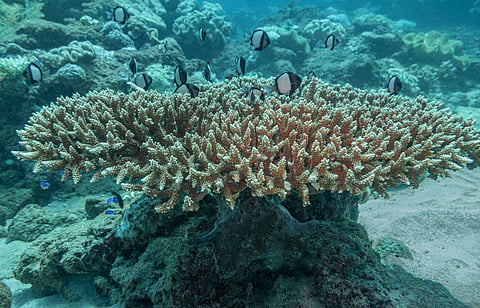

New survey finds nearly 70% of corals at UNESCO-listed Ningaloo Reef have died.
Australia’s most intense and prolonged marine heatwave on record blamed for mass bleaching.
Mortality across eight northern lagoon sites now exceeds 60%.
More than 1,600 corals were assessed in March, but only about 600 survived by October.
Scientists warn the reef is facing unprecedented ecological stress as ocean temperatures surge globally.
The longest-lasting, largest and most intense underwater heatwave ever recorded has decimated nearly 70 per cent of the World Heritage-listed Ningaloo Reef in Western Australia.
Scientists said that between their initial analyses in August 2024 and May 2025, they observed severe bleaching and estimated that 30-90 per cent of corals across the region, including the 1,500-kilometre coastline, had been affected.
In an assessment published in August, coral bleaching-related mortality in northern and central Ningaloo was estimated at 31-60 per cent.
The most recent survey by researchers from Curtin University now shows that coral mortality in eight sites of the reef’s northern lagoon, from the Osprey Sanctuary Zone to the Tantabiddi Sanctuary Zone, has risen to more than 60 per cent.
Of the more than 1,600 individual corals counted and identified in March, only about 600 were still alive by the end of October. “Most of the corals that were bleached in March did not survive,” Zoe Richards, associate professor in the School of Molecular and Life Sciences at Curtin University, wrote in an article for nonprofit news portal The Conversation.
The survey covered a 40-kilometre stretch between the Osprey and Tantabiddi sanctuary zones, an area that includes Turquoise Bay and several of the reef’s most popular tourist sites, according to Australian broadcaster ABC News.
The scale of the loss comes against the backdrop of ocean temperatures reaching record highs. In 2023, global marine heatwaves lasted four times longer than average and affected 96 per cent of the world’s oceans.
Heat began building by the end of 2024 and intensified over subsequent months, placing the reef under prolonged stress.
Scientists said the intense bleaching at the iconic Ningaloo Reef extended to other areas previously considered more resilient, including the offshore Rowley Shoals and the vast but little-documented reefs of the northern Kimberley.
The prolonged heating event during which the entire water column down to 300 metres was superheated has never been recorded before in Australia, Richards wrote in The Conversation.
A few resilient species, including Veron’s tube coral (Echinopora ashmorensis) and lesser knob coral (Cyphastrea microphthalma), have persisted. However, populations of once-dominant species such as staghorn corals (Acropora tenuis, Acropora millepora, Acropora spicifera) and the thin birdsnest coral (Seriatopora hystrix) have died.
Researchers also found many coral branches now infested with sponges, algae and other organisms, reducing the reef’s diversity and structural stability.
Coral reefs support about one-third of marine species globally, and widespread bleaching or mortality undermines their ability to sustain dependent species.
Ningaloo had been under stress even before 2024. Scientists reported that low oxygen levels in March 2022 led to a sharp decline in live coral cover. In areas such as Bills Bay, coral cover fell from about 70 per cent in 2021 to around 1 per cent in 2022, while turf algae rose from 27 per cent to 79 per cent over the same period.
According to the United States National Oceanic and Atmospheric Administration, between January 2023 and 11 September 2025, bleaching-level heat stress affected 84.4 per cent of the world’s coral reef area, with mass bleaching documented in at least 83 countries and territories.